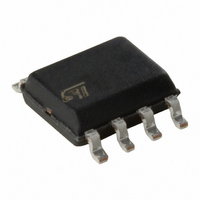TSM101AIDT STMicroelectronics, TSM101AIDT Datasheet - Page 5

TSM101AIDT
Manufacturer Part Number
TSM101AIDT
Description
IC CONTROLLER VOLT & CUR 8 SOIC
Manufacturer
STMicroelectronics
Datasheet
1.TSM101CDT.pdf
(13 pages)
Specifications of TSM101AIDT
Function
Charge Management
Battery Type
All Battery Types
Voltage - Supply
4.5 V ~ 32 V
Operating Temperature
-40°C ~ 105°C
Mounting Type
Surface Mount
Package / Case
8-SOIC (0.154", 3.90mm Width)
Number Of Outputs
1
Output Current
20 mA
Input Voltage
4.5 V to 32 V
Supply Current
2 mA
Mounting Style
SMD/SMT
Maximum Operating Temperature
+ 105 C
Minimum Operating Temperature
- 40 C
Lead Free Status / RoHS Status
Lead free / RoHS Compliant
Other names
497-2331-2
Available stocks
Company
Part Number
Manufacturer
Quantity
Price
Part Number:
TSM101AIDT
Manufacturer:
ST
Quantity:
20 000
Part Number:
TSM101AIDT M101AI
Manufacturer:
ST
Quantity:
20 000
This technical note shows how to use the TSM101
integrated circuit with a switching mode power
supply (SMPS) to realize a battery charger.
An example of realization of a 12V Nickel-cadmi-
um battery charger is given.
1 - TSM101 PRESENTATION
The TSM101 integrated circuit incorporates a high
stability series band gap voltage reference, two
ORed operational amplifiers and a current source
(Figure 1)
Figure 1 : TSM101 Schematic Diagram
This IC compares the DC voltage and the current
level at the output of a switching power supply to
an internal reference.It provides a feedback
through an optocoupler to the PWM controller IC
in the primary side.
The controlled current generator can be used to
modify the level of current limitation by offsetting
the information coming from the current sensing
resistor.
A great majority of low or medium end power sup-
plies is voltage regulated by using shunt program-
mable voltage references like the TL431
(Figure 2).
A BATTERY CHARGER USING THE TSM101
The galvanic insulation of the control information
is done by using an opto-coupler in linear mode
with a variable photo current depending on the dif-
ference between the actual output voltage and the
desired one.
A current limitation is used to protect the power
supply against short circuits, but lacks precision.
This limitation is generally realized by sensing the
current of the power transistor, in the primary side
of the SMPS.
The role of the TSM101 is to make a fine regula-
tion of the output current of the SMPS and a pre-
cise voltage limitation.
The primary current limitation is conserved and
acts as a security for a fail-safe operation if a
short-circuit occurs at the output of the charger.
2 - PRINCIPLE OF OPERATION
The current regulation loop and the voltage limita-
tion loop use an internal 1.24V band-gap voltage
reference. This voltage reference has a good pre-
cision (better than 1.5%) and exhibits a very stable
temperature behavior.
The current limitation is performed by sensing the
voltage across the low ohmic value resistor R5
and comparing it to a fixed value set by the bridge
composed by R2 and R3 (Figure 3).
When the voltage on R5 is higher than the voltage
on R3 the output of the current loop operational
amplifier decreases. The optocoupler current in-
creases and tends to reduce the output voltage by
the way of the PWM controller.
The voltage regulation is done by comparing a
part of the output voltage (resistor bridge R6, R7
and P1) to the voltage reference (1.24V).
If this part is higher than 1.24V, the output of the
voltage loop operational amplifier decreases.
APPLICATION NOTE
5/13













